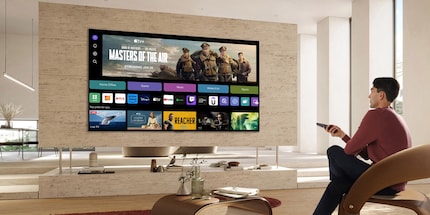
News + Trends
LG's Signature OLED T: Transparent, wireless - and with 3D effect
by Luca Fontana

At the CES in Las Vegas, TV manufacturers got together to reveal the future of the product. This year’s trend? Transparent displays. Exciting? Not to me. I’m looking forward to other developments entirely.
The tech industry recently got to flaunt its innovative side at CES in Las Vegas. As my colleague Samuel Buchmann reported, OLED monitors for PCs proved to be the biggest stars of the future-focused expo. Meanwhile, LG’s first transparent OLED TV also made quite the splash.
My impression of transparent TVs? They look cool, but they’re pointless. It’s marketing, plain and simple. Besides, it’s not as if the concept’s brand new. Even so, LG has reportedly created a better transparent TV than any of its rivals – at least according to nerd gurus like Caleb Denison from Digital Trends or Chris Welch from The Verge. Perhaps in 5-10 years’ time, transparent displays for living rooms really will be as good as they’re supposed to be in theory.
In the meantime, I’m more interested in the immediate future. When push comes to shove, I want to know which innovations I can look forward to most in the upcoming TV review season.
No, it’s not Samsung’s first transparent micro-LED display that gets my pulse racing. Instead, it’s something much more trivial: a brand new anti-glare coating on the S95D, Samsung’s flagship OLED for 2024. Or as Caleb Denison describes it, «where light goes to die».
What does the anti-reflective treatment actually do? Well, exactly what it says on the tin. It protects the display against reflections and glare. This is nothing new, and other TVs do the same thing. What’s new, however, is how incredibly efficient Samsung’s anti-glare layer is. You can see this clearly in the video above, where two artificial windows are placed next to Samsung’s S95D and a 2023 OLED TV. On the old OLED TV, you can see a perfect reflection in the display’s glass. All that can be seen on the S95D, however, is a matt, diffuse light.
If you ask me, that isn’t just fantastic – it’s ridiculously clever. As a result of their technology, OLED TVs are much less bright than LCD models. That’s why people who watch TV more often during the day than at night are better off buying an LCD TV. Since LCDs shine more brightly than the reflections on the display, the glare is barely noticeable. If you’re looking for a new TV right now, here’s a useful article for you:
Year after year, TV manufacturers invest a ton of effort to make OLED televisions brighter and nip the reflection issue in the bud. They do a pretty good job. Televisions such as LG’s G3 or Sony’s A95L are now so bright that they’re no longer rendered useless by daylight-flooded living rooms. The trouble is, the brighter an OLED shines, the hotter it gets. This in turn increases the risk of burn-in, a problem OLEDs are much more susceptible to than LCDs.
This time, Samsung’s putting the OLED cart before the horse. Instead of simply making the TV brighter and more susceptible to burn-in, the matt anti-glare treatment is designed to eliminate the actual problem – reflections. Smart, right? However, as Caleb Denison explains in the video above, there’s a reason why other manufacturers didn’t develop anti-glare coatings a long time ago. Coatings don’t just make reflections on the screen become more matt and therefore much less noticeable – they also do it to the display itself.
This might hit completely the wrong note with customers. After all, as was the case with plasma TVs back in the day, the glossy look is a hallmark of OLED displays (Caleb describes it as a «wet» look). This makes colours appear much bolder, with stronger contrasts than on matt LCD displays. But no matter. I’m still looking forward to reviewing it. Especially because I’ll finally get to see with my own eyes whether the new anti-glare treatment really does make colours that matt.
LG presented the biggest TV surprise on the market last year. Despite its «ageing» OLED technology with white subpixels, the South Korean tech giant produced one of the brightest OLED televisions of the year. This was down to two innovative improvements:
Together, they form the foundation of META Technology; the convex microlenses ensure that light produced is focused and amplified. Meanwhile, META Booster (the algorithm) increases the maximum brightness. On top of that, there’s the additional heat sink already used last year and the deuterium composition of the panel, which is particularly heat resistant. This allows the display to shine brighter without overheating and increasing the risk of burn-in.

In its press release, LG says it’s analysed large amounts of data on previous MLA technology and optimised the angle of the lenses. It also claims the META booster algorithm has been significantly improved and that, thanks in part to the new Alpha 11 chipset, it’s more powerful.
That’s bound to get the nerds’ attention. Alpha 11? Didn’t LG only just use the sixth-generation Alpha 9 chip in last year’s flagship? Yep. In using the Alpha 11, LG probably wants to send a clear signal. Not only is LG not releasing the «seventh» generation of the now-established Alpha 9 chip, it’s also skipping an entire version number. The intention? To express just how much better the new chip will be. LG is promising a 70 per cent increase in graphics performance and a 30 per cent increase in general processor performance.
I can hardly wait to review the upcoming G or M series (the M series is new and wireless). LG has promised a peak brightness of 3,000 nits in the 77-inch version of its two flagships. Realistic? Just a year ago, LG promised a peak brightness of 2,100 nits with META 1.0. To me, that sounded like science fiction. And not unjustifiably so:. When I reviewed the G3 later, I actually «only» measured 1,800 nits in the bright but poorly calibrated Vivid mode. Even so, it still made the G3 one of the brightest OLED TVs ever. Most of the time, manufacturers get a little too excited in publishing their figures.
With this in mind, it’s unlikely the 3,000-nit mark will be broken. If it happens, I’ll be flabbergasted. I’d probably be happy enough with the 2,000-nit mark – at least in the rather dark but brilliantly calibrated Dolby Vision mode. That’d be 600 nits more than last year. And anything else the hugely improved chipset and AI assistance gets out of the image will be a bonus.
It’s been the subject of rumours for a long time. And at CES 2024, it was finally unveiled: the Hisense UX, probably the brightest TV in the world. Rather than an OLED, it’s a mini-LED TV. All the number nerds out there better hold on to their hats. Hisense isn’t just promising over 40,000 dimming zones in the 110-inch version of the TV – it’s also promising a peak HDR brightness of 10,000 nits! For comparison, the brightest mini-LED TV I’ve ever reviewed was Samsung’s QN95B, which came to just over 2,100 nits in Filmmaker mode.
Don’t worry, Hisense isn’t trying to burn your eyes out. The peak brightness should really only come into play in really bright areas of the onscreen image, such as the sun, a spotlight, a torch or a candle. Despite the TV’s immense brightness, Hisense is also promising minimal blooming and consistently accurate colours that never fade.
I’m psyched. To put all this into perspective, if you measure the brightness (not the peak brightness) of a regular OLED picture, the TV emits around 200 nits, depending of course on whether a bright or dark scene is being displayed. A mini LED TV comes in at around 600 nits. I personally find that almost marginally bright, especially in the evening. Will Hisense show restraint? Or will it aim to break records, even with a normal picture? Is that even comfortable on the eye? Whatever the case, the TV’s crying out to be reviewed.
What do you think? Have I missed anything important, groundbreaking or surprising? Let me know in the comments.
Header image: Samsung QD-OLED S95D/Samsung Newsroom.
I write about technology as if it were cinema, and about films as if they were real life. Between bits and blockbusters, I’m after stories that move people, not just generate clicks. And yes – sometimes I listen to film scores louder than I probably should.
Interesting facts about products, behind-the-scenes looks at manufacturers and deep-dives on interesting people.
Show all
Background information
by Luca Fontana

Background information
by Luca Fontana

Background information
by Luca Fontana